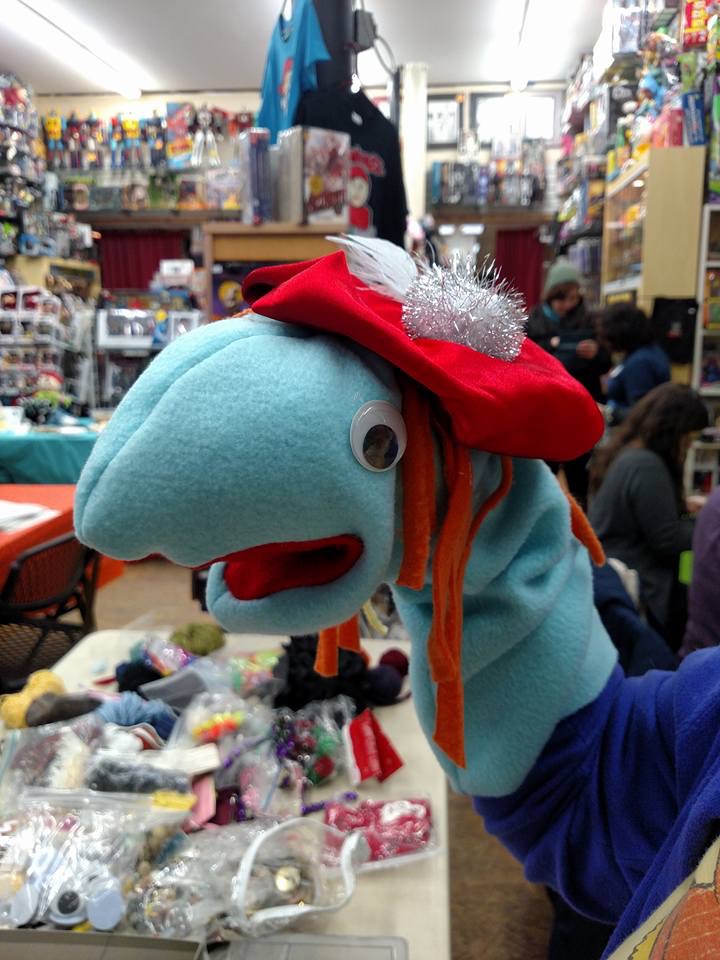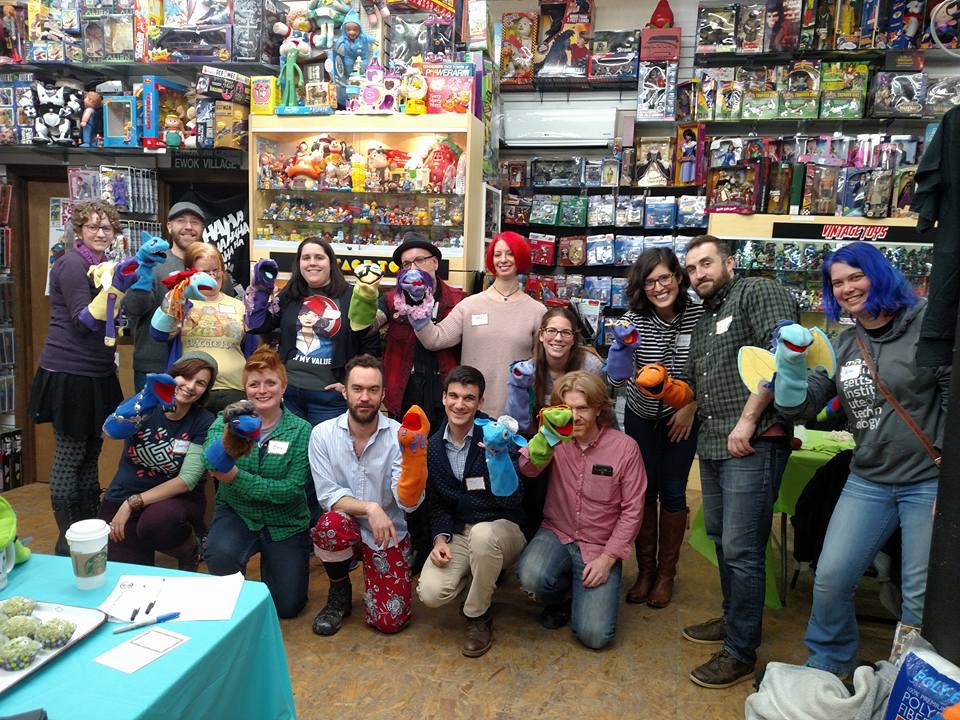Puppetry Tips and Tricks
 If you joined us for our puppet making event, you're now the proud owner of a unique, handmade puppet. If you didn't, you may still have a random puppet lurking around your house somewhere. Or maybe you're looking at that sock that doesn't seem to match any of the others in the laundry basket and wondering if it's meant for better things. Wherever you are in the puppet making process, it's important to remember that building the puppet is only part of the experience. Here are some ideas for what to do with your newly made felted friend.
If you joined us for our puppet making event, you're now the proud owner of a unique, handmade puppet. If you didn't, you may still have a random puppet lurking around your house somewhere. Or maybe you're looking at that sock that doesn't seem to match any of the others in the laundry basket and wondering if it's meant for better things. Wherever you are in the puppet making process, it's important to remember that building the puppet is only part of the experience. Here are some ideas for what to do with your newly made felted friend.
Practice Expressions
If you plan on performing for other people with your puppet, chances are that the puppet will spend a lot of time looking at something or someone other than you. So familiarizing yourself with your puppet's potential range of expressions and what you have to do to create them is an important first step.
Put your puppet through its paces emotionally. Don't just focus on static expressions. See if you can maintain the emotion with the mouth closed and open, or while the puppet talks. Try to come up with specific scenarios - a surprise birthday party, missing a bus, encountering a clown where a clown shouldn't be - and see what kind of expressions result. If you're stuck for inspiration, try watching some random YouTube videos and letting your puppet react to them. What you come up with and what you and your puppet are physically capable of will start to determine your puppet's personality.
https://youtube.com/watch?v=SzjKNki3AYo
Lip Synch
Lip synching may be controversial in the music world, but it's perfectly acceptable in the world of puppets. Some of the very first Henson shorts featured puppets lip synching to popular songs. Performing to existing material lets you focus on performance and timing of the mouth movements without the added difficulty of performing a consistent voice or coming up with your own dialogue. It's also a great way to try out different attitudes and personalities as you start to develop your puppet's character.
Pick a shorter song to start with. (Save Bohemian Rhapsody or American Pie for when you've had more practice.) Once you've run through the song face to face with your puppet, you can try filming it to get a sense of how it looks to an audience.
Read a Story
As you develop a voice for your puppet, you'll want to make sure it's something you can recreate again and again no matter what your puppet is feeling or doing. Reading a few children's books, fairy tales, or other short stories can help you to practice the voice and further refine your puppet's personality. As you start to figure out who your puppet is, you can modify the material to suit the puppet. Have the puppet make comments on the plot and characters, or insert itself into the story and tell the tale from a particular point of view.
Having your puppet tell a story is also good practice for the next idea...
https://youtu.be/ayanb2UYVTQ
Talk To Some Kids
If you want to use your puppet for more than just entertaining yourself, you're going to have to perform for an audience sooner or later. Young children are often happy to watch a puppet performance, but can also force you to improvise in order to keep their attention or respond to unexpected questions. You can try out a one on one performance for your own children or a friend's kid. If you think you're ready for a bigger challenge, check around for birthday parties, day camps, or local libraries that might be interested in a puppet performance.

Make Some Friends
Lots of projects are easier when more people get involved and puppeteering is no different. For a simple sock puppet, a making a friend may be as easy as putting a puppet on your other hand. But you may want to bring other performers into the mix too. It gives you another performance to work off of and takes some of the pressure of the performance off of you. You might also find people willing to help with other aspects of the performance, such as set design, prop building, filming, editing, or promotion. All of which could be essential if you want to take the next step and....
https://youtu.be/_qfuWJzo82k
Put on a Show
Making the puppet, developing its voice and personality, and honing your puppeteering skills is all leading up to putting on a show. The scope of the show and the size of the audience are totally up to you. You can simply duck behind the couch and do a one-time solo performance for your family and close friends. You can make an elaborate production with a cast of hundreds, detailed scenery, and complex editing and put it on YouTube for all the world to see. Those options and anything in between are all open to you. You have access to far more tools and resources than many of the greatest puppeteers of all time did. So if you want to make something with your puppet and show it to people, you absolutely can.
We'd love to see photos or videos of your puppets, whether they come from our puppet making event, a store, your box of fabric scraps, or anywhere else. Share your puppets with us in the comments.
